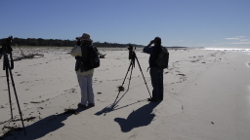|
|
Inventory, assessment and monitoring of shorebirds and other waterbirdsInventory, assessment, monitoring and research, although sometimes used interchangeably, have different meanings. The descriptions below outline the differences in relation to shorebirds and other waterbirds. Other parts of this website relating to shorebirds and other waterbirds include: Quick facts
InventoryFor shorebirds and other waterbirds, inventory is the term used for the collection of information on species composition, seasonal occurrence, abundance and breeding of birds. As many species are migratory or move irregularly, and as the condition of wetlands are highly variable, the results of an inventory are usually only considered comprehensive after a series of surveys are undertaken over a number of years. For example, where rainfall/or bird movements are erratic and unreliable, longer series of data may be required. As the focus of an inventory is to build a comprehensive knowledge base, a suite of information collection methods may be required. Inventory is not necessarily constrained to standardised areas, time frames or methods. The very high mobility of birds and the variation in habitat within a wetland means that searches of the entire wetland area may give optimal results for inventory purposes. Assessment (including Waterbird Population Estimates)For shorebirds and other waterbirds, assessment involves the analysis of existing data against criteria for a specific purpose, such as evaluating relative importance. As many birds are conspicuous and readily counted, they provide a very effective means to identify conservation and management priorities. For sustainable management of shorebird and other waterbird habitat, it is necessary to understand a habitat's relative importance against a set of priorities or criteria to ensure the best conservation outcomes. Internationally accepted criteria have been in use for many decades under the Ramsar Convention for identifying sites of international importance. Criteria 5 and 6 of the Ramsar Convention relate to the total number of waterbirds and the percentage of the flyway population at a wetland over multiple seasons. Robust data from counts of waterbirds at the wetland site is required to determine this. Ramsar Criterion 4 relates to critical stages of an animal's life cycle. For birds, examples include breeding, moulting and migration. Wetlands International's online database Waterbird Population Estimates (WPE) has been endorsed by the Ramsar Convention for applying Criterion 6. A large proportion of the Wetlands of International Importance in Australia and worldwide have been designated on the basis of assessment of waterbird count data. Presently, waterbirds are among the very few elements of biodiversity which can be assessed in this way and at global scale. A revision of the East Asian-Australasian Flyway Population estimates for 37 listed migratory shorebird species have been published by the Australian government to account for updated information and is used in revised thresholds. The criteria for the East Asian–Australasian Flyway Site Network are similar to those of the Ramsar Convention, e.g. supporting 1% of the population size of a migratory waterbird in the Flyway and/or >20,000 waterbirds. Sites may be nominated by partner governments using the WPE database for calculating the percentage of the flyway population estimates. Large-scale inventory and assessment is vital for management of waterbirds and their habitats. Estimates of population size depend on analysis of count data, typically from throughout a species’ range of occurrence. An adequate understanding of the significance of numbers of a waterbird at a managed wetland may depend on knowing its population size, as well as it's present distribution and abundance elsewhere. These considerations are vital in regard to migratory shorebirds and important for waterbirds that move extensively across Australia. MonitoringFor shorebirds and other waterbirds, monitoring involves measuring changes over time. Short-term monitoring programs may arise from the need to understand the impact of a new development on waterbirds or the outcomes of a management intervention, such as control of weeds in a wetland. Long-term monitoring programs could be used to look at the impacts on waterbirds from changes to water quantity or quality in a catchment. This monitoring is likely to be coordinated at a larger scale and involve multiple groups or agencies, e.g. the aerial surveys of waterbirds in Eastern Australia conducted annually since the mid-1980s by the University of New South Wales and other agencies and groups. At this scale it is possible to assess how the regulation of rivers, water harvesting and patterns in climate, such as prolonged drought, can affect waterbird populations. All monitoring of waterbirds should adhere to methods that have been chosen to deliver consistent data that can be robustly analysed with high confidence. Much waterbird monitoring is not complex and can be readily performed by non-professionals with appropriate training. ResearchResearch is usually undertaken by academic institutions and addresses specific questions. Examples of research include studies to review the taxonomic status of populations; defining the ecological requirements of particular species; plotting migration pathways; or identifying factors that limit the success of breeding. For migratory shorebirds, the conservation and management of East Asian—Australasian flyway populations necessitate knowledge and research into:
Additional Information
Pages under this sectionLast updated: 25 January 2021 This page should be cited as: Department of Environment, Science and Innovation, Queensland (2021) Inventory, assessment and monitoring of shorebirds and other waterbirds, WetlandInfo website, accessed 18 March 2024. Available at: https://wetlandinfo.des.qld.gov.au/wetlands/assessment/water-bird-research-assessment/ |

 — Department of Environment, Science and Innovation
— Department of Environment, Science and Innovation


